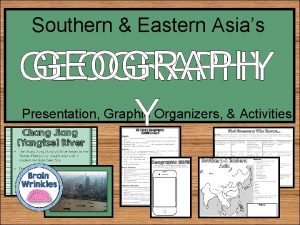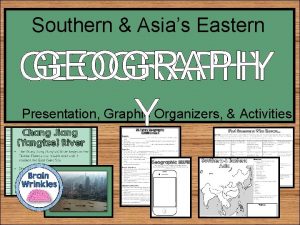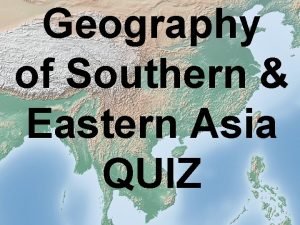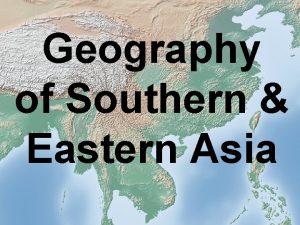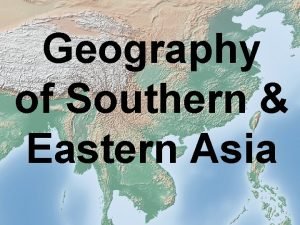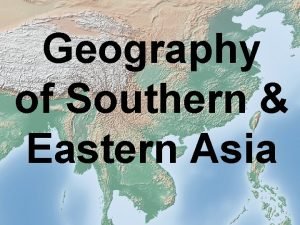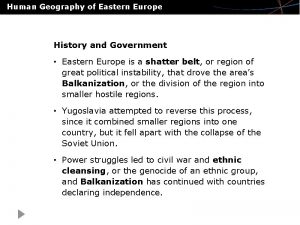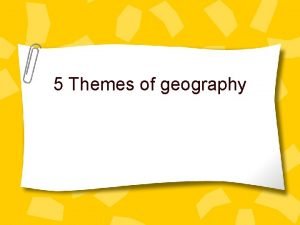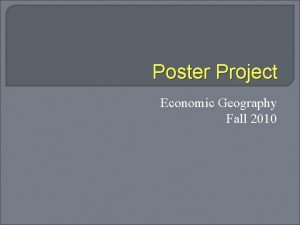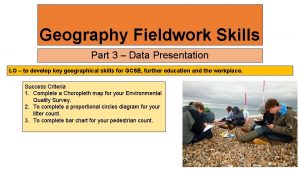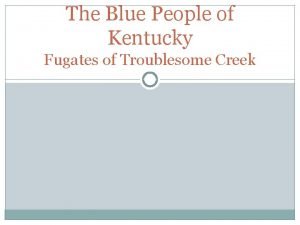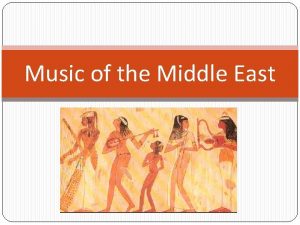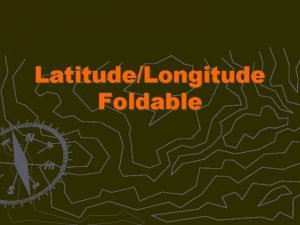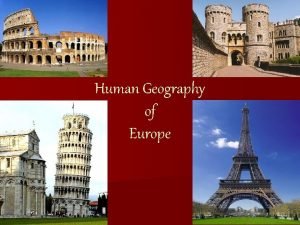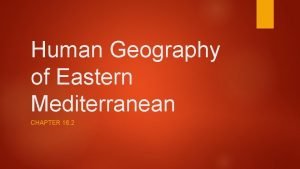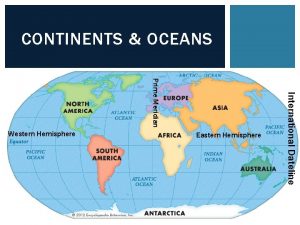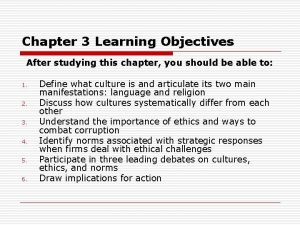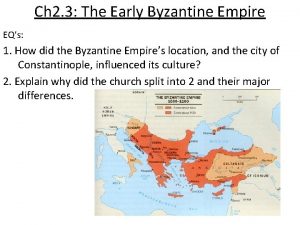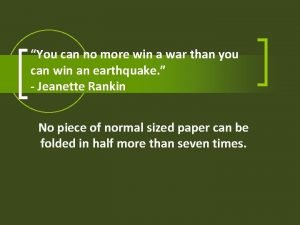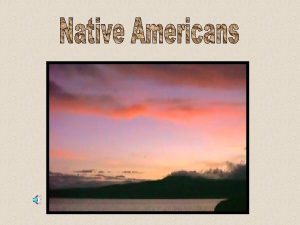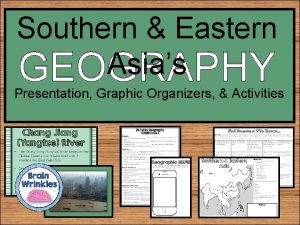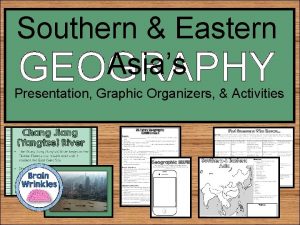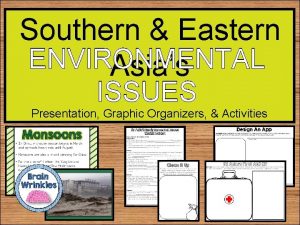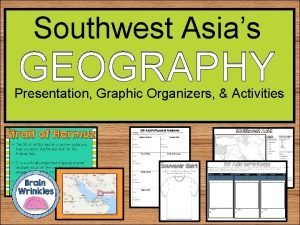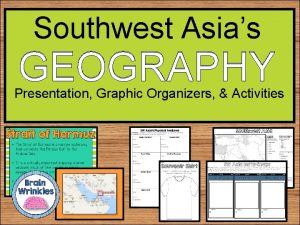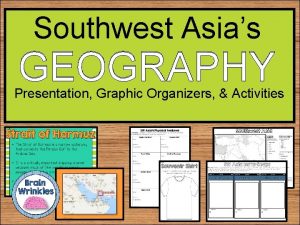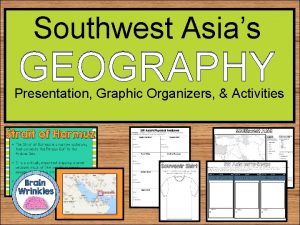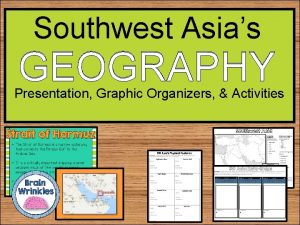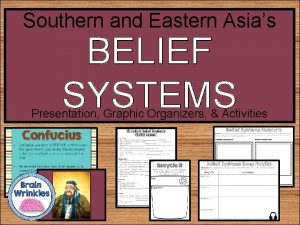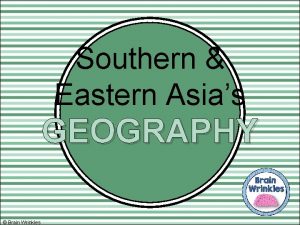Southern Eastern Asias GEOGRAPHY Y Presentation Graphic Organizers









































































- Slides: 73

Southern & Eastern Asia’s GEOGRAPHY Y Presentation, Graphic Organizers, & Activities

STANDARDS: SS 7 G 9 Locate selected features in Southern and Eastern Asia. a. Locate on a world and regional political-physical map: Ganges River, Huang He (Yellow River), Chang Jiang (Yangtze) River, Bay of Bengal, Indian Ocean, Sea of Japan, South China Sea, Yellow Sea, Gobi Desert, Taklimakan Desert, Himalayan Mountains, and Korean Peninsula. b. Locate on a world and regional political-physical map the countries of China, India, Japan, North Korea, South Korea, and Vietnam. © Brain Wrinkles

Instructional Activities for Geography of SE Asia • Students will be placed into 3 -4 groups after completing their cloze notes. Each group should spend no more than 15 minutes in each station and then rotate. If time runs out, students will have another day to complete all of the assignments in each group. • Group 1 : Using their cloze notes and laptops, this group 1 will complete the map that allows them to identify each physical feature discussed in the previous lesson. Students will color each physical feature and create a map code that will allow them to identify that feature. Once students have completed the physical features map, then they will be instructed to identify each country on a separate map provided. Students will be able to use world maps that are located in class.

Southern & Eastern Asia Directions: Label the following countries on the political map of SE Asia: • • • Map Key © Brain Wrinkles China India Japan North Korea South Korea Vietnam

Southern & Eastern Asia Directions: 1. Label the following physical features: • Ganges River • Huang He (Yellow River) • Chang Jiang (Yangtze) River • Bay of Bengal • Indian Ocean • Sea of Japan • South China Sea • Yellow Sea • Gobi Desert • Taklimakan Desert • Himalayan Mountains • Korean Peninsula 2. Create a map key that includes symbols for: • Rivers • Mountains • Deserts • Bays • Seas • Oceans • Peninsulas 3. Draw the symbol for each feature next to the correct label on the map. Color all symbols! Map Key © Brain Wrinkles

SE Asia’s Geography CLOZE Notes 1 Geography • Asia is the ___________ with a total land area of more than 17 million square miles. • More than ___________ live in Southern and Eastern Asia, with over half of that number living in China and India alone. • The continent has a ___________ of physical features, including deserts, peninsulas, and the world’s highest mountains. Ganges River • The Ganges River starts ___________ and flows southeast through India and Bangladesh for more than 1, 500 miles to the Indian Ocean. • The name comes from a Hindu goddess and the river is considered ___________ religion. • It is the most important river to the ___________. • The river runs through India’s most ___________ and densely populated areas. • Because so many people live and work along the Ganges, the water in the river is ___________. Huang He (Yellow River) • The Huang He, or Yellow River, begins in the ___________ of Tibet and flows east to the Yellow Sea. • This is China’s ___________ river. • Chinese ___________ in the central area of this river basin. • The river is named for the ___________ that it carries along its path to the Yellow Sea. • The silt creates rich topsoil for farmers; however, ___________ make the river’s path dangerous. • It’s nickname is “China’s Sorrow” because of the ___________. Chang Jiang (Yangtze) River • The Chang Jiang (Yangtze) River begins in the Tibetan Plateau and ___________ until it reaches the East China Sea. • It’s the ___________ river in China (over 3, 400 miles) and the third-longest in the world. • The Chang Jiang empties into the ___________. • The Chang Jiang is extremely important for China because it provides ___________ , water for irrigation, and transportation for cargo ships. • The Chang Jiang and Huang He Rivers are connected by one of the world’s ___________ systems, the Grand Canal. • Some parts were built over ___________ ago. © Brain Wrinkles

SE Asia’s Geography CLOZE Notes 2 Bay of Bengal • The Bay of Bengal is an extension of the ___________. • The Bay of Bengal ___________ on its west and Myanmar on its east. • ___________ and many other large rivers flow into this bay. Indian Ocean • The Indian Ocean is the ___________ of Earth’s five oceans. • It is located between Africa to the west, ___________ , and Australia to the east. Sea of Japan • The Sea of Japan is a small sea that is bound by Russia to the north, the Korean Peninsula to the west, and ___________. • It is an arm of the Pacific Ocean that lies between the ___________ and Japan. • The sea has large deposits of mineral resources and abundant fish, both of which are important to ___________. South China Sea • The South China sea is located ___________ and the Philippines. • The South China Sea connects the ___________ oceans, so many of the world’s international shipping channels run through it. • There are often ___________ and typhoons in this region. Yellow Sea • The Yellow Sea is an extension of the Pacific Ocean that lies ___________ and the Korean Peninsula. • The Huang He (Yellow River) empties into the ___________. • It becomes the East China Sea south of the ___________. • The Yellow Sea is well-known for its ___________. • Unfortunately, in recent years, many species of ___________ in the Yellow Sea due to overfishing by some countries. © Brain Wrinkles

SE Asia’s Geography CLOZE Notes 3 Gobi Desert • The Gobi Desert is Asia’s ___________. • It expands across southern Mongolia and ___________. • Much of the Gobi Desert is covered with sand ___________ that is exposed by powerful winds blowing across the region. • The Gobi Desert is known as “Shamo”, the Chinese word for ___________. • It can be one of the hottest and also ___________ places on earth. Taklimakan Desert • The Taklimakan Desert lies between two rugged mountain ranges in ___________. • It is over 600 miles in length, making it one of the ___________ in the world. • ___________ cover 85% of its surface. • The Taklimakan Desert receives ___________ annual precipitation. • The plant and animal life in this desert have had to adapt to the ___________ in order to survive. Himalayan Mountains • The Himalayas lie along the ___________ of the Indian subcontinent and the southern border of China. • They form the ___________ between India and China. • The mountains stretch for about ___________. • The Himalayan mountain range is the ___________ mountain region. • It is sometimes called “the roof of the world” because of the ___________. • Nine of the world’s ten ___________ are located here. • ___________, the world’s highest mountain, is part of the Himalayan range. Korean Peninsula • The Korean Peninsula is a mountainous peninsula that juts ___________ in between the Yellow Sea and the Sea of Japan. • Over half of the peninsula is made up of mountains, but there is still plenty of ___________. • Since the end of World War II in 1948, the peninsula has been divided into ___________ : North Korea (communist) and South Korea (democratic). © Brain Wrinkles

Southern & Eastern Asia’s GEOGRAPHY © Brain Wrinkles

Geography • Asia is the world’s largest continent with a total land area of more than 17 million square miles. • More than 4 billion people live in Southern and Eastern Asia, with over half of that number living in China and India alone. • The continent has a wide variety of physical features, including deserts, peninsulas, and the world’s highest © Brain Wrinkles

© Brain Wrinkles

Ganges River • The Ganges River starts in the Himalayas and flows southeast through India and Bangladesh for more than 1, 500 miles to the Indian Ocean. • The name comes from a Hindu goddess and the river is considered sacred to the Hindu religion. • It is the most important river to the Indian subcontinent. © Brain Wrinkles

© Brain Wrinkles

© Brain Wrinkles

Ganges River • The river runs through India’s most fertile farmland densely populated areas. • Because so many people live and work along the Ganges, the water in the river is heavily polluted. © Brain Wrinkles

© Brain Wrinkles

Huang He (Yellow River) • The Huang He, or Yellow River, begins in the mountainous plateau of Tibet and flows east to the Yellow Sea. • This is China’s second-longest river. • Chinese civilization began in the central area of this river basin. © Brain Wrinkles

© Brain Wrinkles

© Brain Wrinkles

Huang He (Yellow River) • The river is named for the muddy yellow silt that it carries along its path to the Yellow Sea. • The silt creates rich topsoil for farmers; however, annual floods make the river’s path dangerous. • It’s nickname is “China’s Sorrow” because of the frequent flooding. © Brain Wrinkles

© Brain Wrinkles

Chang Jiang (Yangtze) River • The Chang Jiang (Yangtze) River begins in the Tibetan Plateau and travels east until it reaches the East China Sea. • It’s the largest and longest river in China (over 3, 400 miles) and the third-longest in the world. • The Chang Jiang empties into the Pacific Ocean. © Brain Wrinkles

© Brain Wrinkles

© Brain Wrinkles

Chang Jiang (Yangtze) River • The Chang Jiang is extremely important for China because it provides hydroelectric power, water for irrigation, and transportation for cargo ships. • The Chang Jiang and Huang He Rivers are connected by one of the world’s oldest canal systems, the Grand Canal. • Some parts were built over 2, 000 years ago. © Brain Wrinkles

© Brain Wrinkles

Bay of Bengal • The Bay of Bengal is an extension of the Indian Ocean. • The Bay of Bengal touches India on its west and Myanmar on its east. • The Ganges and many other large rivers flow into this bay. © Brain Wrinkles

© Brain Wrinkles

© Brain Wrinkles

© Brain Wrinkles

Indian Ocean • The Indian Ocean is the third largest of Earth’s five oceans. • It is located between Africa to the west, Asia to the north, and Australia to the east. © Brain Wrinkles

© Brain Wrinkles

Sea of Japan • The Sea of Japan is a small sea that is bound by Russia to the north, the Korean Peninsula to the west, and Japan to the east. • It is an arm of the Pacific Ocean that lies between the Asian continent and Japan. • The sea has large deposits of mineral resources and abundant fish, both of which are important to Japan’s economy. © Brain Wrinkles

© Brain Wrinkles

© Brain Wrinkles

South China Sea • The South China sea is located between Vietnam and the Philippines. • The South China Sea connects the Pacific and Indian oceans, so many of the world’s international shipping channels run through it. • There are often violent monsoons and typhoons in this region. © Brain Wrinkles

© Brain Wrinkles

© Brain Wrinkles

Yellow Sea • The Yellow Sea is an extension of the Pacific Ocean that lies between China and the Korean Peninsula. • The Huang He (Yellow River) empties into the Yellow Sea. • It becomes the East China Sea south of the Korean Peninsula. © Brain Wrinkles

© Brain Wrinkles

Yellow Sea • The Yellow Sea is well-known for its fishing industry. • Unfortunately, in recent years, many species of fish have declined in the Yellow Sea due to overfishing by some countries. © Brain Wrinkles

© Brain Wrinkles

Gobi Desert • The Gobi Desert is Asia’s largest desert. • It expands across southern Mongolia and northern China. • Much of the Gobi Desert is covered with sand bare rock that is exposed by powerful winds blowing across the region. © Brain Wrinkles

© Brain Wrinkles

© Brain Wrinkles

Gobi Desert • The Gobi Desert is known as “Shamo”, the Chinese word for “sand desert”. • It can be one of the hottest and also one of the coldest places on earth. © Brain Wrinkles

© Brain Wrinkles

Taklimakan Desert • The Taklimakan Desert lies between two rugged mountain ranges in northwestern China. • It is over 600 miles in length, making it one of the longest deserts in the world. • Giant sand dunes cover 85% of its surface. © Brain Wrinkles

© Brain Wrinkles

© Brain Wrinkles

Taklimakan Desert • The Taklimakan Desert receives very little annual precipitation. • The plant and animal life in this desert have had to adapt to the dry environment in order to survive. © Brain Wrinkles

© Brain Wrinkles

Himalayan Mountains • The Himalayas lie along the northern edge of the Indian subcontinent and the southern border of China. • They form the natural border between India and China. • The mountains stretch for about 200 miles. © Brain Wrinkles

© Brain Wrinkles

© Brain Wrinkles

Himalayan Mountains • The Himalayan mountain range is the world’s highest mountain region. • It is sometimes called “the roof of the world” because of the area’s high altitudes. © Brain Wrinkles

© Brain Wrinkles

Himalayan Mountains • Nine of the world’s ten largest peaks are located here. • Mt. Everest, the world’s highest mountain, is part of the Himalayan range. © Brain Wrinkles

© Brain Wrinkles

Korean Peninsula • The Korean Peninsula is a mountainous peninsula that juts out of northeastern China in between the Yellow Sea and the Sea of Japan. • Over half of the peninsula is made up of mountains, but there is still plenty of rich farmland. © Brain Wrinkles

© Brain Wrinkles

Korean Peninsula • Since the end of World War II in 1948, the peninsula has been divided into two countries: North Korea (communist) and South Korea (democratic). © Brain Wrinkles

© Brain Wrinkles

Instructional Activities for Geography of SE Asia • Students will be placed into 3 -4 groups after completing their cloze notes. Each group should spend no more than 15 minutes in each station and then rotate. If time runs out, students will have another day to complete all of the assignments in each group. • Group 2 : Using their cloze notes, these students will complete the SE Asia’s Physical Features chart. This will allow students to work with one another and read their notes for understanding and break down the “What and Where” about each Physical feature. Students will also be allowed to create an illustration about each feature. By creating this chart, this will help students become more familiar with the physical features of SE Asia.

SE Asia’s Physical Features Directions: Complete the chart below with information that you learn during the presentation. If time allows, color your illustrations. What: Where: What: Sea of Japan Bay of Bengal Huang He (Yellow River) Where: Illustration: Ganges River Illustration: What: Where: Chang Jiang (Yangtze) River Where: Illustration: Indian Ocean Illustration: Where: What: Illustration: What: Where: Illustration: © Brain Wrinkles

SE Asia’s Physical Features What: Where: What: Yellow Sea Directions: Complete the chart below with information that you learn during the presentation. If time allows, color your illustrations. Where: Illustration: South China Sea Illustration: What: Korean Peninsula Taklimakan Desert What: Where: Gobi Desert Where: Illustration: Himalayan Mountains Illustration: Where: What: Illustration: What: Where: Illustration: © Brain Wrinkles

Instructional Activities for Geography of SE Asia • Students will be placed into 3 -4 groups after completing their cloze notes. Each group should spend no more than 20 minutes in this group and then rotate. If time runs out, students will have another day to complete all of the assignments in each group. • Group 3 : Students will work in pairs in this station. Using a copy of a completed labeled map, they will have 10 minutes to review the location for each of the countries. Once time is up, the students will begin to play the game Roll A Six! You will work with a partner, with only 1 pencil to share. • When I say “Go”, one person will begin labeling the map as fast as you can. • The other person should start rolling the dice. As soon as you roll a 6, you take the pencil and begin labeling your map. Your partner should start rolling the dice now. • This is a race to see who can complete the map first, but the catch is you can only label your map if you roll a 6!

Roll A Six! • You will work with a partner, with only 1 pencil to share. • When I say “Go”, one person will begin labeling the map as fast as you can. • The other person should start rolling the dice. As soon as you roll a 6, you take the pencil and begin labeling your map. Your partner should start rolling the dice now. • This is a race to see who can complete the map first, but the catch is you can only label your map if you roll a 6! © Brain Wrinkles

Southern & Eastern Asia

Instructional Activities for Geography of SE Asia • Students will be placed into 3 -4 groups after completing their cloze notes. Each group should spend no more than 15 minutes in each station and then rotate. If time runs out, students will have another day to complete all of the assignments in each group. • Group 4 : Using their cloze notes, these students will complete the You Are Now Entering sheet. The students will have to choose one of SE Asia’s physical features and create a “welcome sign” that visitors will see as they enter the feature’s region. The sign should include key facts about the feature, as well as significant illustrations. Students will be allowed to use chart paper to make a bigger illustration of their sign.

You Are Now Entering… Directions: Choose one of SE Asia’s physical features and create a “welcome sign” that visitors will see as they enter the feature’s region. The sign should include key facts about the feature, as well as significant illustrations. © Brain Wrinkles

Instructional Activities for Geography of SE Asia • TEACHER INFO: TICKET OUT THE DOOR • Have students write down five important things that they learned about SE Asia’s physical features. If time, call on students to share. • Collect these as the students leave the classroom.

 What is asias largest desert
What is asias largest desert Science staar supplemental aids
Science staar supplemental aids Staar blank place value chart
Staar blank place value chart Staar blank graphic organizers
Staar blank graphic organizers Hierarchical topical organizer
Hierarchical topical organizer Human read aloud mcas
Human read aloud mcas Censogram
Censogram Blank graphic organizers for math staar
Blank graphic organizers for math staar Marzanos strategies
Marzanos strategies Mcas graphic organizer
Mcas graphic organizer Brain wrinkles southern and eastern asia
Brain wrinkles southern and eastern asia Label the following
Label the following South asia physical features
South asia physical features Southern and eastern asia physical features
Southern and eastern asia physical features Se asia geography cloze notes 1
Se asia geography cloze notes 1 Brain wrinkles southern and eastern asia
Brain wrinkles southern and eastern asia Southern and eastern asia's belief systems answer key
Southern and eastern asia's belief systems answer key Southern and eastern asia physical features answer key
Southern and eastern asia physical features answer key Southern and eastern asia physical features answer key
Southern and eastern asia physical features answer key Lesson 1 physical geography of eastern europe
Lesson 1 physical geography of eastern europe Human geography of eastern europe
Human geography of eastern europe Middle east map
Middle east map Southern colonies geography
Southern colonies geography Emanata graphic novel
Emanata graphic novel Ghost graphic story graphic and wayfinding
Ghost graphic story graphic and wayfinding Cues, questions, and advance organizers
Cues, questions, and advance organizers Example of narrative advance organizer
Example of narrative advance organizer Expository advance organizers examples
Expository advance organizers examples Dear organizers
Dear organizers Discourse analysis and vocabulary
Discourse analysis and vocabulary Marzano's 9 high yield strategies
Marzano's 9 high yield strategies Cues questions and advance organizers
Cues questions and advance organizers Skimming advance organizer
Skimming advance organizer 5 themes of geography graphic organizer
5 themes of geography graphic organizer Ap human geography political geography frq
Ap human geography political geography frq 5 themes of geography ap human geography
5 themes of geography ap human geography Proruption ap human geography
Proruption ap human geography Geography poster presentation
Geography poster presentation Complex data presentation geography
Complex data presentation geography Diameters of fetal head
Diameters of fetal head Leopold maneuver
Leopold maneuver Eastern front line ww1
Eastern front line ww1 Freemasony
Freemasony Webdhis kzn login
Webdhis kzn login Eastern woodlands landforms
Eastern woodlands landforms Eastern and western roman empire map
Eastern and western roman empire map Blue fugates family
Blue fugates family 7 ties to the oes obligation
7 ties to the oes obligation Pompey's eastern settlement
Pompey's eastern settlement Eastern woodlands homes
Eastern woodlands homes Aerophone
Aerophone East west hemisphere
East west hemisphere Central eastern italy
Central eastern italy Far eastern art
Far eastern art Ussr control over eastern europe igcse
Ussr control over eastern europe igcse What is considered eastern europe
What is considered eastern europe Chapter 16 eastern mediterranean answers
Chapter 16 eastern mediterranean answers Honor flight portland oregon
Honor flight portland oregon Eastern woodland tribes
Eastern woodland tribes Eastern woodlands shelter
Eastern woodlands shelter Eastern philosophy
Eastern philosophy Eastern kentucky university aviation
Eastern kentucky university aviation Similarities between eastern and western absolutism
Similarities between eastern and western absolutism Is poland considered eastern europe
Is poland considered eastern europe Secneer
Secneer Eastern hemisphere oceans
Eastern hemisphere oceans Western values vs eastern values
Western values vs eastern values Roman catholic vs eastern orthodox
Roman catholic vs eastern orthodox Family with blue skin
Family with blue skin Stalingrad war
Stalingrad war No limits eastern shore
No limits eastern shore University of eastern colorado firewatch
University of eastern colorado firewatch Landforms in southern europe
Landforms in southern europe Eastern woodland location
Eastern woodland location










